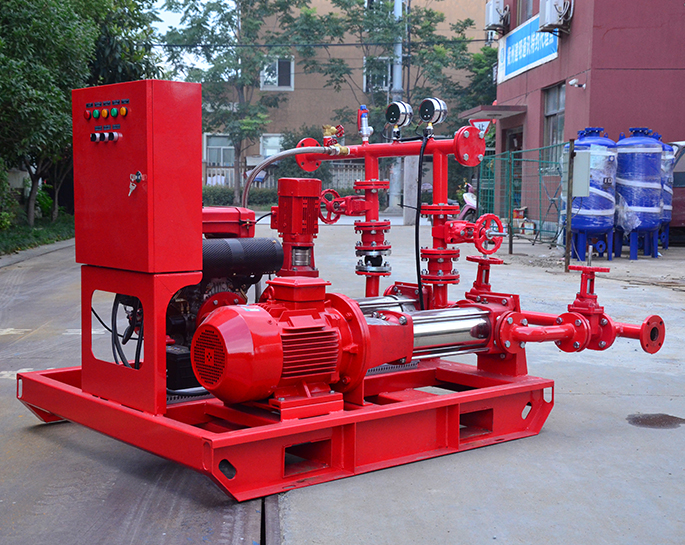What factors should be considered when sizing a diesel fire pump?
Mar 06, 2024
Share:
Sizing a diesel fire pump involves several factors to ensure that it meets the specific requirements and standards for fire protection. Here are some key factors to consider:
1. **Flow Rate and Pressure Requirements**: Determine the required flow rate and pressure based on the size and occupancy of the building, as well as the potential fire hazards. This information is usually specified by local fire codes and standards such as NFPA 20.
2. **Hydraulic Design**: Consider the hydraulic characteristics of the fire protection system, including the layout of piping, elevation changes, friction losses, and required pressure at the most remote sprinkler or hydrant.
3. **System Demand**: Evaluate the demand of the fire protection system under various scenarios, including maximum occupancy, worst-case fire scenarios, and any additional water demands for special hazards.
4. **Water Supply**: Assess the available water supply, such as municipal water mains, water tanks, or natural bodies of water. Ensure that the pump is capable of drawing water from the available source and providing the required flow and pressure.
5. **Fuel Supply**: Ensure that there is an adequate and reliable fuel supply for the diesel engine, considering factors such as fuel storage capacity, fuel quality, and fuel delivery systems.
6. **Standby Power Requirements**: Determine the need for standby power generation to ensure continuous operation of the fire pump during power outages. This may involve sizing the generator based on the power requirements of the pump and other critical systems.
7. **Environmental Conditions**: Consider environmental factors such as ambient temperature, altitude, and potential exposure to corrosive or hazardous conditions, which can affect the performance and longevity of the diesel fire pump.
8. **Compliance with Standards**: Ensure that the design and installation of the diesel fire pump comply with relevant standards and regulations, such as NFPA 20 (Standard for the Installation of Stationary Pumps for Fire Protection) and local building and fire codes.
9. **Reliability and Redundancy**: Design the system with redundancy and reliability in mind to minimize the risk of pump failure during a fire emergency. This may involve specifying backup pumps, redundant power sources, and automatic transfer switches.
10. **Lifecycle Costs**: Consider the lifecycle costs of the diesel fire pump, including initial purchase, installation, maintenance, and fuel consumption. Optimize the design to achieve the best balance between performance, reliability, and cost-effectiveness over the life of the system.
By carefully considering these factors, you can ensure that the diesel fire pump is appropriately sized and designed to provide reliable and effective fire protection for the intended application.

1. **Flow Rate and Pressure Requirements**: Determine the required flow rate and pressure based on the size and occupancy of the building, as well as the potential fire hazards. This information is usually specified by local fire codes and standards such as NFPA 20.
2. **Hydraulic Design**: Consider the hydraulic characteristics of the fire protection system, including the layout of piping, elevation changes, friction losses, and required pressure at the most remote sprinkler or hydrant.
3. **System Demand**: Evaluate the demand of the fire protection system under various scenarios, including maximum occupancy, worst-case fire scenarios, and any additional water demands for special hazards.
4. **Water Supply**: Assess the available water supply, such as municipal water mains, water tanks, or natural bodies of water. Ensure that the pump is capable of drawing water from the available source and providing the required flow and pressure.
5. **Fuel Supply**: Ensure that there is an adequate and reliable fuel supply for the diesel engine, considering factors such as fuel storage capacity, fuel quality, and fuel delivery systems.
6. **Standby Power Requirements**: Determine the need for standby power generation to ensure continuous operation of the fire pump during power outages. This may involve sizing the generator based on the power requirements of the pump and other critical systems.
7. **Environmental Conditions**: Consider environmental factors such as ambient temperature, altitude, and potential exposure to corrosive or hazardous conditions, which can affect the performance and longevity of the diesel fire pump.
8. **Compliance with Standards**: Ensure that the design and installation of the diesel fire pump comply with relevant standards and regulations, such as NFPA 20 (Standard for the Installation of Stationary Pumps for Fire Protection) and local building and fire codes.
9. **Reliability and Redundancy**: Design the system with redundancy and reliability in mind to minimize the risk of pump failure during a fire emergency. This may involve specifying backup pumps, redundant power sources, and automatic transfer switches.
10. **Lifecycle Costs**: Consider the lifecycle costs of the diesel fire pump, including initial purchase, installation, maintenance, and fuel consumption. Optimize the design to achieve the best balance between performance, reliability, and cost-effectiveness over the life of the system.
By carefully considering these factors, you can ensure that the diesel fire pump is appropriately sized and designed to provide reliable and effective fire protection for the intended application.







